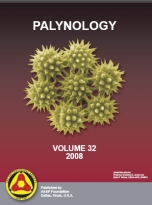During a detailed palynological study of the Milk River Formation in southern Alberta, Canada, a diverse and well-preserved assemblage of fungi including dispersed fungal spores and isolated fragments of microthyriaceous fruiting bodies were encountered and these are described. Based on ammonites, magnetostratigraphy, and palynomorphs, these strata are dated as latest Santonian to ?earliest Campanian (Late Cretaceous). This palynomorph assemblage represents one of the few documented occurrences of fungi of this age. Eighteen genera of fungal spores and three of microthyriaceous thyriothecia, comprising 45 species are recorded. The fungal assemblage is characterized by species of toruloid spores in chains, and cylindrical spores belonging to Dicellaesporites, Diporicellaesporites, Pluricellaesporites, Reduviasporonites, and Scolecosporites that mainly occur as saprophytes today. Helicoid spores belonging to Involutisporonites and Paragranatisporites are also represented and these generally occur in marshy and swamp-like conditions in an open environment mainly characterized by taxodiaceous forest. Microthyriaceous thyriothecia are represented by several specimens of Asterothyrites menonii, Phragmothyrites eocaenicus, and Trichothyrites sp. Although the assemblage consists of diverse fungal taxa, the dispersed spores and fruiting structures are not abundant, and only a few scattered specimens for many species were recorded. One reason for the low frequency may have been the unfavorable paleoenvironmental conditions which prevailed in these marine to nearshore terrestrial depositional settings. In spite of the low abundances, it is thought that documentation of the fungal occurrences in these strata will be of importance in future biostratigraphic and evolutionary studies of fungi. Many of the fungal species encountered are distinctive and probably restricted stratigraphically, being different from those recorded from the better documented Paleogene/Neogene assemblages, and may prove to be biostratigraphically useful.
How to translate text using browser tools
1 December 2008
Santonian To ?Earliest Campanian (Late Cretaceous) Fungi from the Milk River Formation, Southern Alberta, Canada
Ramakant M. Kalgutkar,
Dennis R. Braman
ACCESS THE FULL ARTICLE
It is not available for individual sale.
This article is only available to subscribers.
It is not available for individual sale.
It is not available for individual sale.

Palynology
Vol. 32 • No. 1
December 2008
Vol. 32 • No. 1
December 2008
Alberta
Canada
fungal spores
Late Cretaceous
Late Santonian–?early Campanian
Milk River Formation
taxonomy




